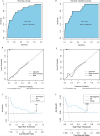Development and validation of a nomogram for predicting the occurrence of renal dysfunction after treatment of immune checkpoint inhibitor: a retrospective case-control study
- PMID: 38760047
- PMCID: PMC11103235
- DOI: 10.1136/bmjopen-2023-082484
Development and validation of a nomogram for predicting the occurrence of renal dysfunction after treatment of immune checkpoint inhibitor: a retrospective case-control study
Abstract
Purpose: The administration of immune checkpoint inhibitors (ICIs) may lead to renal adverse events, notably including renal dysfunction. To early predict the probability of renal dysfunction after ICIs therapy, a retrospective case-control study was conducted.
Methods: Clinical information on ICIs-treated patients was collected. Multivariable logistic regression was applied to identify risk factors for renal dysfunction after ICIs treatment. Moreover, a nomogram model was developed and validated internally.
Results: A total of 442 patients were included, among which 35 (7.9%) experienced renal dysfunction after ICIs treatment. Lower baseline estimated glomerular filtration rate (eGFR) (OR 0.941; 95% CI 0.917 to 0.966; p<0.001), concurrent exposure of platinum(OR 4.014; 95% CI 1.557 to 10.346; p=0.004), comorbidities of hypertension (OR 3.478; 95% CI 1.600 to 7.562; p=0.002) and infection (OR 5.402; 95% CI 1.544 to 18.904; p=0.008) were found to be independent associated with renal dysfunction after ICIs treatment. To develop a predictive nomogram for the occurrence of renal dysfunction after ICIs treatment, the included cases were divided into training and validation groups in a ratio of 7:3 randomly. The above four independent risk factors were included in the model. The area under the receiver operating characteristic curves of the predictiive model were 0.822 (0.723-0.922) and 0.815 (0.699-0.930) in the training and validation groups, respectively.
Conclusions: Lower baseline eGFR, platinum exposure, comorbidities of hypertension and infection were predictors of renal dysfunction in ICIs-treated patients with cancer. A nomogram was developed to predict the probability of renal dysfunction after ICIs treatment, which might be operable and valuable in clinical practice.
Keywords: IMMUNOLOGY; Nephrology; ONCOLOGY; Pharmacology; Risk Factors.
© Author(s) (or their employer(s)) 2024. Re-use permitted under CC BY-NC. No commercial re-use. See rights and permissions. Published by BMJ.
Conflict of interest statement
Competing interests: None declared.
Figures



Similar articles
-
Development and validation of a nomogram model for predicting immune-mediated hepatitis in cancer patients treated with immune checkpoint inhibitors.Biosci Trends. 2025 May 9;19(2):202-210. doi: 10.5582/bst.2024.01351. Epub 2025 Feb 1. Biosci Trends. 2025. PMID: 39894525
-
Development and validation of a nomogram for predicting immune-mediated colitis in lung cancer patients treated with immune checkpoint inhibitors: a retrospective cohort study in China.Front Immunol. 2025 Jan 30;16:1510053. doi: 10.3389/fimmu.2025.1510053. eCollection 2025. Front Immunol. 2025. PMID: 39949779 Free PMC article.
-
Development and validation of a nomogram model for predicting venous thromboembolism risk in lung cancer patients treated with immune checkpoint inhibitors: A cohort study in China.Cancer Med. 2024 Aug;13(16):e70115. doi: 10.1002/cam4.70115. Cancer Med. 2024. PMID: 39162396 Free PMC article.
-
New biomarkers exploration and nomogram construction of prognostic and immune-related adverse events of advanced non-small cell lung cancer patients receiving immune checkpoint inhibitors.Respir Res. 2023 Feb 27;24(1):64. doi: 10.1186/s12931-023-02370-0. Respir Res. 2023. PMID: 36849947 Free PMC article.
-
A nomogram for predicting the 4-year risk of chronic kidney disease among Chinese elderly adults.Int Urol Nephrol. 2023 Jun;55(6):1609-1617. doi: 10.1007/s11255-023-03470-y. Epub 2023 Jan 31. Int Urol Nephrol. 2023. PMID: 36720744 Review.
References
Publication types
MeSH terms
LinkOut - more resources
Full Text Sources
Research Materials
Miscellaneous
